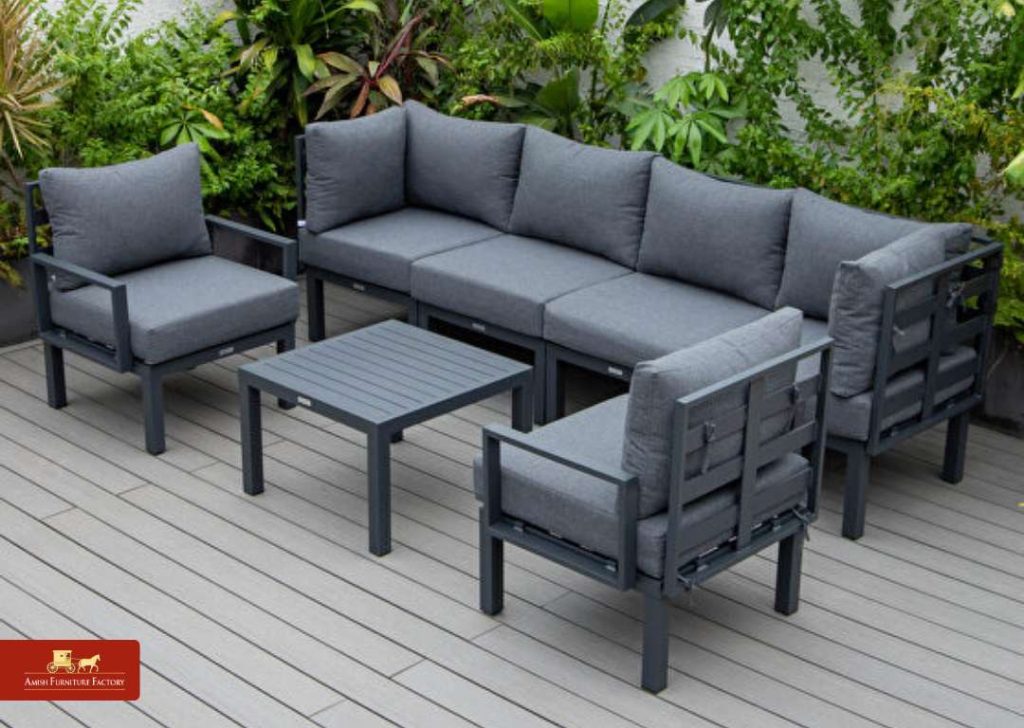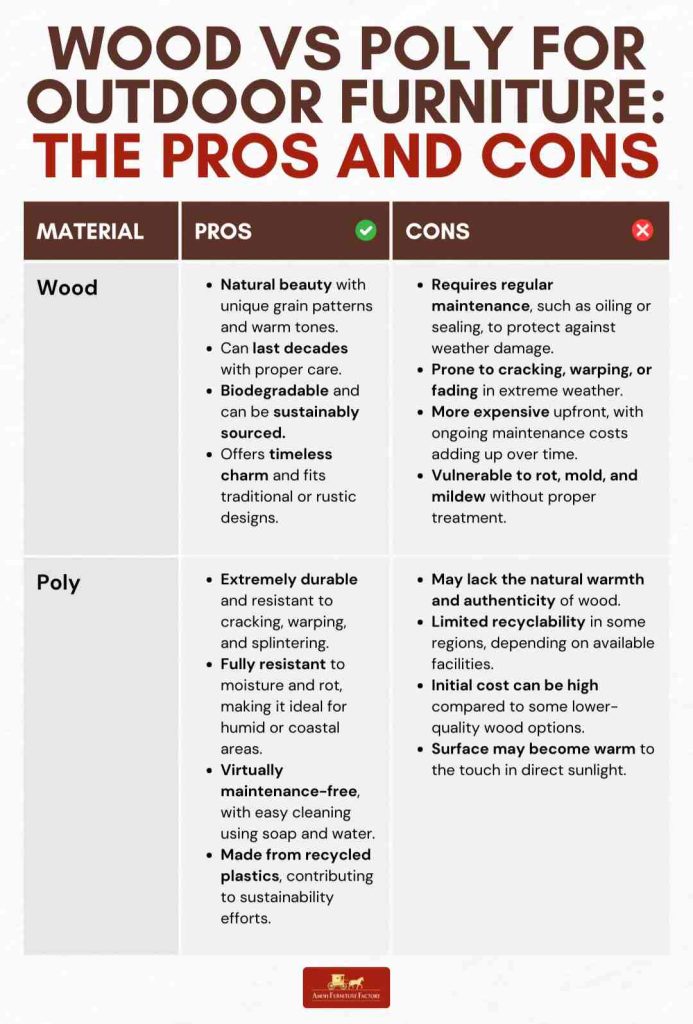
The material you choose for outdoor furniture can transform your outdoor space into a haven of comfort and style. With so many options available, wood vs poly stand out as two of the most popular and reliable choices. Each offers unique benefits and challenges, making it essential to understand which works best for your specific needs.
Key Takeaways
- Selecting the right material is crucial as it affects the longevity, maintenance needs, and overall aesthetic of your outdoor space.
- Wood furniture requires regular maintenance to prevent wear and tear, while poly is virtually maintenance-free and resistant to harsh weather conditions.
- Poly is ideal for humid, coastal, or extreme weather areas, while wood works best in dry, mild climates with proper care.
- Wood offers natural beauty and timeless appeal, whereas poly provides modern versatility and durability, with eco-friendly benefits due to recycled materials.
This guide highlights the strengths, weaknesses, and ideal uses for both materials, helping you make an informed decision that complements your lifestyle and outdoor environment.
Outdoor Wood Furniture: An Overview

Wood has long been a classic choice for outdoor furniture due to its natural beauty and versatility. Different types of wood offer varying levels of durability, appearance, and maintenance care guide, so selecting the right one is essential for your outdoor space.
Choosing and identifying the right wood is crucial for ensuring your furniture lasts through changing weather conditions. Here are the most common options:
- Teak: Known for its exceptional durability and resistance to water and insects, teak is a favorite for outdoor furniture. It develops an elegant silvery patina over time if left untreated.
- Cedar: Lightweight and naturally resistant to decay, cedar is ideal for humid climates. Its pleasant aroma is an added bonus.
- Eucalyptus: A more affordable alternative to teak, eucalyptus offers good resistance to moisture and rot. It’s a sustainable option for eco-conscious buyers.
- Acacia: Durable and visually appealing, acacia wood performs well in outdoor conditions with regular care and oiling.
- Pine: Often treated to withstand the elements, pine wood is an economical choice, though it requires consistent maintenance to prevent wear.
Wood furniture offers timeless charm and design flexibility, fitting well into many outdoor settings. It is naturally resistant to insects and rot, and when well-maintained, can last for decades. The warmth and unique grain patterns of wood add a natural appeal that synthetic materials may not replicate. Wood is biodegradable, making it a more environmentally friendly choice for eco-conscious homeowners.
A Look at Poly Outdoor Furniture

High-density polyethylene (HDPE) is a durable, low-maintenance plastic commonly used in products that need to withstand wear and environmental stress. Known for being lightweight yet sturdy, HDPE is resistant to moisture, rot, and insects, making it ideal for outdoor applications. Often made from recycled plastics like milk jugs, HDPE is an eco-friendly material with a non-porous surface that prevents staining and is easy to clean with just soap and water.
In outdoor furniture, HDPE is used to create poly furniture, which offers exceptional durability and minimal upkeep. Designed to withstand harsh weather conditions, poly furniture resists fading, warping, and cracking. Its lightweight nature makes it easy to move and rearrange, and it comes in a variety of colors and finishes. While poly furniture can get warm to the touch in high temperatures and may slightly fade with extended sun exposure, its long-lasting performance and eco-friendly properties make it a sustainable and convenient choice for outdoor spaces. However, access to recycling facilities for HDPE may vary by location.
Wood vs. Poly: A Head-to-Head Comparison for Outdoor Use
When selecting outdoor furniture, comparing wood and poly side by side can help clarify which material best suits your needs. Each material has unique strengths and drawbacks depending on durability, maintenance, and overall cost.

Durability in Outdoor Conditions
Wood furniture, especially hardwoods like teak and eucalyptus, offers excellent durability when properly maintained. However, exposure to extreme weather can lead to cracking, warping, or fading over time. Poly furniture is engineered to withstand harsh conditions without deteriorating, making it a dependable choice for year-round use. Unlike wood, poly won’t crack, splinter, or warp, even in humid or rainy climates.
Resistance to Moisture and Rot
Many types of outdoor wood, like cedar and teak, have natural oils that resist moisture, but they can still succumb to rot without regular sealing. Poly furniture is entirely resistant to moisture and rot, making it ideal for humid or coastal areas. While wood can develop mold or mildew if left untreated, poly’s non-porous surface prevents such issues. This makes poly a better option for locations with frequent rain or high humidity.
Maintenance and Cleaning Requirements
Wood furniture requires regular upkeep, such as oiling, staining, or sealing, to protect it from the elements. Cleaning wood often involves gentle scrubbing to remove dirt and prevent mildew. Poly furniture, by contrast, is virtually maintenance-free and only needs a quick wash with soap and water. Its durability reduces the need for ongoing care, making it a more convenient option for busy homeowners.
Environmental Impact and Sustainability
Wood is biodegradable and can be sustainably sourced, especially from certified forests, but overharvesting can be an environmental concern. Poly is made from recycled plastics, giving new life to materials that might otherwise end up in landfills. However, recycling poly at the end of its life may not be feasible in all areas. Both materials have eco-friendly benefits, but their sustainability depends on sourcing and disposal practices.
Aesthetic Appeal in Outdoor Spaces
Wood’s natural grain and warm tones bring a timeless, organic beauty to outdoor settings. Each piece of wood furniture is unique, with variations that enhance its charm. Poly furniture offers a wide range of colors and finishes, some of which mimic wood, but it may lack the authentic feel of natural materials. Choosing between the two depends on whether you prioritize tradition or modern versatility in design.
Price Range and Long-Term Cost Efficiency
Wood furniture often requires a higher upfront investment, particularly for premium options like teak or acacia. Over time, maintenance costs for treatments and finishes can add up. Poly furniture tends to have a lower long-term cost due to its minimal upkeep and long lifespan. While it may be expensive initially, its durability and lack of ongoing care make it a cost-effective choice over the years.

Discover quality, durability, and style for your home with our handcrafted Amish furniture. Visit Amish Furniture Factory today to explore options that fit your lifestyle perfectly! Explore now
Factors to Consider When Choosing Between Wood and Poly
When deciding between wood and poly, consider your lifestyle and climate. Wood requires more maintenance but offers a classic look, while poly is nearly maintenance-free and better suited for extreme weather. Both materials have their strengths, so think about how each will fit your outdoor space and how much upkeep you’re willing to do.
Wood is ideal for traditional or rustic settings, offering natural beauty and warmth. It works well in milder climates and is a good option for homeowners who enjoy maintaining their furniture with oiling or sealing. If you’re looking for a timeless, elegant look and don’t mind regular upkeep, wood is a great choice.
Poly, on the other hand, is perfect for harsh weather conditions, such as coastal or humid areas, because it resists moisture and rot. It’s low-maintenance, needing only occasional cleaning, and is lightweight, making it easy to move or rearrange. With a wide range of colors, poly is also a great option for modern, vibrant outdoor spaces.
Here’s a guide highlighting how each type holds up to different weather conditions:

Making the Right Choice for Your Outdoor Space
Choosing between wood and poly outdoor furniture ultimately depends on your preferences, climate, and lifestyle. Wood offers timeless charm and natural elegance, while poly provides durability and ease of maintenance. Both materials have distinct strengths, making them suitable for different settings and priorities.
By considering factors like upkeep, cost, and design preferences, you can confidently select furniture that complements your outdoor area. The key is finding a balance between functionality and aesthetics to enhance your space for years to come.
FAQs
Can poly outdoor furniture fade in direct sunlight?
Poly furniture is designed to resist fading, even when exposed to sunlight for extended periods. High-quality options include UV inhibitors to protect the color. However, over many years, intense sunlight may slightly dull the finish.
How do I protect wood outdoor furniture during winter?
Store wood furniture indoors or cover it with breathable, waterproof covers to prevent moisture damage during winter. Avoid using plastic tarps, as they can trap condensation and cause rot. Regularly clean and seal the wood before winter to enhance its resistance to cold and moisture.
Is poly outdoor furniture safe for coastal environments?
Yes, poly furniture is an excellent choice for coastal areas because it resists salt, moisture, and humidity. Its non-porous surface prevents damage from the elements, making it highly durable. It’s a practical option for homeowners near the sea who want low-maintenance outdoor furniture.
What is the average lifespan of wood outdoor furniture vs. poly?
High-quality wood furniture can last 10-30 years with regular maintenance, depending on the type of wood and climate conditions. Poly furniture typically lasts 20 years or more with minimal upkeep. Both options can offer longevity, but poly is less dependent on routine care.
Can poly outdoor furniture be recycled at the end of its life?
Poly furniture is recyclable, as it’s made from high-density polyethylene (HDPE). Many recycling centers accept this material, though availability may vary by location. Recycling poly ensures it can be repurposed into new products, contributing to sustainability efforts.
